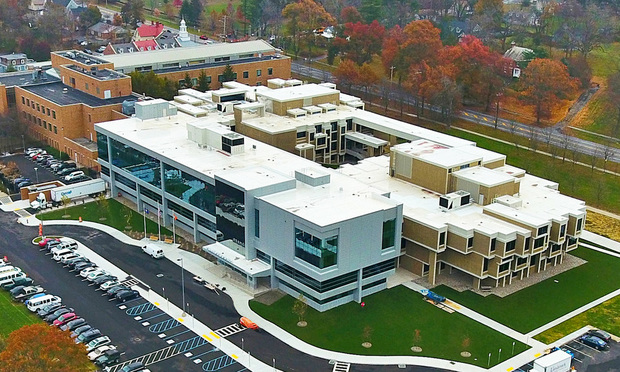Orange County Supreme Court Is on Verge of Judicial Homecoming
But the structure has been controversial in Orange County since it opened to the public in 1970. The roofs leaked, and visitors had trouble navigating the gloomy interior.
May 21, 2018 at 03:36 PM
6 minute read
 Orange County Government Center in Goshen. The court section of the building is the modernistic looking section adjacent to the red building (the annex).
Orange County Government Center in Goshen. The court section of the building is the modernistic looking section adjacent to the red building (the annex). Almost seven years after it was forced out of its quarters by two violent storms, the Orange County Supreme Court is on the verge of a judicial homecoming.
But the patience of exiled court personnel must stretch a little further.
A dozen county agencies already have moved back into the renovated three-winged, three-story Orange County Government Center in Goshen about 60 miles northwest of the George Washington Bridge. Only the court is still occupying temporary space.
Officials initially hoped for the building's six courtrooms to be back in business in May, but it must first receive a final order of furniture and complete needed technology and security work.
“Gut renovating and moving a whole courthouse is a complex logistical ballet with many moving parts,” said Lucian Chalfen, spokesman for the Office of Court Administration (OCA). “As of now, there is no firm move-in date, but we anticipate a move during the latter part of the summer.”
However, court personnel are confident that the renovated court, once it is occupied, will represent a significant improvement over its predecessor. It will offer access to the disabled that didn't exist when it opened, beefed up security, acoustic panels and ceilings to soak up noise and—although the number of courtrooms remains the same—added conference rooms.
The court “will have a more opening and welcoming feel,” Ronald Younkins, the recently retired executive director of the OCA said in an interview. He added that the closing, frustrating though it has been, gave officials “a chance to reshape how the building operates. The building is 50 years old. It was time to rethink.”
The modernistic government center of which the court is a tenant was evacuated after it was slammed by Hurricane Irene on Aug. 28-29, 2011. It was reopened on Sept. 6 but closed indefinitely on Sept. 8 after further damage from Tropical Storm Lee.
As debate swirled around Orange County on how to correct the situation, court officials were caught in a maelstrom of local politics, financing issues and disputes over the preservation of what many architectural critics regarded as an iconic structure.
The government center was designed by famed architect Paul Rudolph, the dean of the Yale School of Architecture and a disciple of the so-called “brutalist” school. The complex—with its vast interior spaces, exposed concrete and 87 roofs—was among his most admired projects.
But the structure has been controversial in Orange County since it opened to the public in 1970. The roofs leaked, and visitors had trouble navigating the gloomy interior. Local residents also complained that its appearance conflicted with the Goshen's quaint colonial and Victorian dwellings.
After the 2011 deluges, county officials discussed razing the entire government center but instead opted for $74 million in repairs. The Rochester firm of Clark Patterson produced a plan to preserve and renovate two-thirds of the existing structure, including the court section. One other section was torn down and replaced by a new 80,000-square-foot building that serves as an entryway to the county offices.
Fans of Rudolph and brutalism were outraged at the fate of his building, which in 2012 was placed on the World Monuments Fund watch list of threatened cultural sites around the world.
Manhattan architect Gene Kaufman who unsuccessfully offered to purchase the government center, turn it into an artist lofts and exhibit space and design a new government building for the county, called the Clark Patterson project “bastardized version” of Rudolph's vision and “an abomination.”
Jason Streb, the leader of the design team for the government center, acknowledged that Rudolph was a “world-renowned” architect, but said his government center had not weathered the test of time.
The courts didn't take any position on the preservation issue. But officials became increasingly impatient as they waited for the adequate judicial facilities it was the county's duty to provide in place of its “emergency” fixes.
Supreme Court proceedings, in what one nonjudicial employee described as a “whirlwind” of activity, moved into an annex that also housed County Court and Family Court. For a while, court personnel had to post notices to tell lawyers where they were to show up for their cases on a given day.
Two 400-square-foot waiting rooms in the annex were converted into cramped courtrooms. Later, another courtroom part was recommissioned about 0.3 miles away in the “1841 Courthouse,” which hadn't been used as a courthouse in 40 years. Busy lawyers had to shuttle back and forth between the two venues.
In June 2012, Younkins wrote to County Executive Edward A. Diana threatening the county with sanctions if it didn't immediately develop a plan to address the state concerns. “We weren't bluffing,” he said recently. “It was a serious threat.”
In May 2013, the state's Court Facilities Capital Review Board approved the county's plan to “fully restore” the lost court facilities. But Younkins became alarmed that the county was backsliding and wrote in December 2014 that “changing direction at this time—just a few months before the renovation of Division Three [the court wing] was to commence—is unacceptable.”
Justin Rodriguez, a spokesman for Orange County Executive Steven Neuhaus, said in an email that “the executive branch and the courts desired the same thing, a Government Center built on budget and as quickly as reasonably possible. The county worked closely with Ron Younkins during the process. We did remind the county Legislature of the courts authority when we were concerned the funding would be stalled.”
Demolition began in spring of 2015.
This content has been archived. It is available through our partners, LexisNexis® and Bloomberg Law.
To view this content, please continue to their sites.
Not a Lexis Subscriber?
Subscribe Now
Not a Bloomberg Law Subscriber?
Subscribe Now
NOT FOR REPRINT
© 2025 ALM Global, LLC, All Rights Reserved. Request academic re-use from www.copyright.com. All other uses, submit a request to [email protected]. For more information visit Asset & Logo Licensing.
You Might Like
View All
New York-Based Skadden Team Joins White & Case Group in Mexico City for Citigroup Demerger

Bankruptcy Judge Clears Path for Recovery in High-Profile Crypto Failure
3 minute read
US Judge Dismisses Lawsuit Brought Under NYC Gender Violence Law, Ruling Claims Barred Under State Measure
Trending Stories
- 1Starbucks Hands New CLO Hefty Raise, Says He Fosters 'Environment of Courage and Joy'
- 2Blockchain’s Fourth and Fifth Amendment Privacy Paradoxes
- 3Prior Written Notice: Calabrese v. City of Albany
- 4Learning From Experience: The Best and Worst of Years Past
- 5Treasury GC Returns to Davis Polk to Co-Chair White-Collar Defense and Investigations Practice
Who Got The Work
J. Brugh Lower of Gibbons has entered an appearance for industrial equipment supplier Devco Corporation in a pending trademark infringement lawsuit. The suit, accusing the defendant of selling knock-off Graco products, was filed Dec. 18 in New Jersey District Court by Rivkin Radler on behalf of Graco Inc. and Graco Minnesota. The case, assigned to U.S. District Judge Zahid N. Quraishi, is 3:24-cv-11294, Graco Inc. et al v. Devco Corporation.
Who Got The Work
Rebecca Maller-Stein and Kent A. Yalowitz of Arnold & Porter Kaye Scholer have entered their appearances for Hanaco Venture Capital and its executives, Lior Prosor and David Frankel, in a pending securities lawsuit. The action, filed on Dec. 24 in New York Southern District Court by Zell, Aron & Co. on behalf of Goldeneye Advisors, accuses the defendants of negligently and fraudulently managing the plaintiff's $1 million investment. The case, assigned to U.S. District Judge Vernon S. Broderick, is 1:24-cv-09918, Goldeneye Advisors, LLC v. Hanaco Venture Capital, Ltd. et al.
Who Got The Work
Attorneys from A&O Shearman has stepped in as defense counsel for Toronto-Dominion Bank and other defendants in a pending securities class action. The suit, filed Dec. 11 in New York Southern District Court by Bleichmar Fonti & Auld, accuses the defendants of concealing the bank's 'pervasive' deficiencies in regards to its compliance with the Bank Secrecy Act and the quality of its anti-money laundering controls. The case, assigned to U.S. District Judge Arun Subramanian, is 1:24-cv-09445, Gonzalez v. The Toronto-Dominion Bank et al.
Who Got The Work
Crown Castle International, a Pennsylvania company providing shared communications infrastructure, has turned to Luke D. Wolf of Gordon Rees Scully Mansukhani to fend off a pending breach-of-contract lawsuit. The court action, filed Nov. 25 in Michigan Eastern District Court by Hooper Hathaway PC on behalf of The Town Residences LLC, accuses Crown Castle of failing to transfer approximately $30,000 in utility payments from T-Mobile in breach of a roof-top lease and assignment agreement. The case, assigned to U.S. District Judge Susan K. Declercq, is 2:24-cv-13131, The Town Residences LLC v. T-Mobile US, Inc. et al.
Who Got The Work
Wilfred P. Coronato and Daniel M. Schwartz of McCarter & English have stepped in as defense counsel to Electrolux Home Products Inc. in a pending product liability lawsuit. The court action, filed Nov. 26 in New York Eastern District Court by Poulos Lopiccolo PC and Nagel Rice LLP on behalf of David Stern, alleges that the defendant's refrigerators’ drawers and shelving repeatedly break and fall apart within months after purchase. The case, assigned to U.S. District Judge Joan M. Azrack, is 2:24-cv-08204, Stern v. Electrolux Home Products, Inc.
Featured Firms
Law Offices of Gary Martin Hays & Associates, P.C.
(470) 294-1674
Law Offices of Mark E. Salomone
(857) 444-6468
Smith & Hassler
(713) 739-1250







